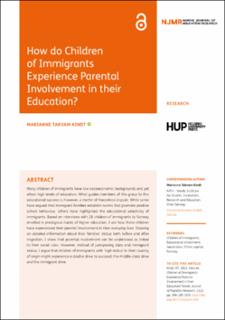| dc.contributor.author | Kindt, Marianne Takvam | |
| dc.date.accessioned | 2022-11-03T14:28:23Z | |
| dc.date.available | 2022-11-03T14:28:23Z | |
| dc.date.created | 2022-09-02T10:49:04Z | |
| dc.date.issued | 2022 | |
| dc.identifier.citation | Nordic Journal of Migration Research. 2022, 12 (2), 190-205. | en_US |
| dc.identifier.issn | 1799-649X | |
| dc.identifier.uri | https://hdl.handle.net/11250/3029971 | |
| dc.description.abstract | Many children of immigrants have low socioeconomic backgrounds and yet attain high levels of education. What guides members of this group to this educational success is, however, a matter of theoretical dispute. While some have argued that immigrant families establish norms that promote positive school behaviour, others have highlighted the educational selectivity of immigrants. Based on interviews with 28 children of immigrants to Norway enrolled in prestigious tracks of higher education, I ask how these children have experienced their parents’ involvement in their everyday lives. Drawing on detailed information about their families’ status both before and after migration, I show that parental involvement can be understood as linked to their social class. However, instead of juxtaposing class and immigrant status, I argue that children of immigrants with ‘high status’ in their country of origin might experience a double drive to succeed: the middle-class drive and the immigrant drive. | en_US |
| dc.language.iso | eng | en_US |
| dc.title | How do Children of Immigrants Experience Parental Involvement in their Education? | en_US |
| dc.title.alternative | How do Children of Immigrants Experience Parental Involvement in their Education? | en_US |
| dc.type | Peer reviewed | en_US |
| dc.type | Journal article | en_US |
| dc.description.version | publishedVersion | en_US |
| dc.source.pagenumber | 190-205 | en_US |
| dc.source.volume | 12 | en_US |
| dc.source.journal | Nordic Journal of Migration Research | en_US |
| dc.source.issue | 2 | en_US |
| dc.identifier.doi | 10.33134/njmr.458 | |
| dc.identifier.cristin | 2048209 | |
| cristin.ispublished | true | |
| cristin.fulltext | original | |
| cristin.qualitycode | 1 | |
